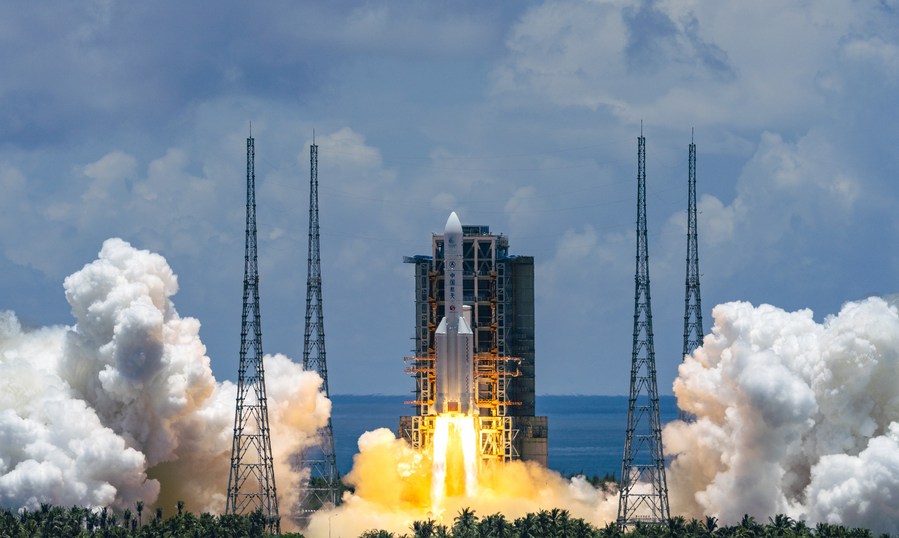
A Mars probe is launched on a Long March-5 rocket from the Wenchang Spacecraft Launch Site in south China's Hainan Province, July 23, 2020. (Xinhua/Cai Yang)
BEIJING, July 26 (Xinhua) -- China's Mars spacecraft has embarked on a long journey with great risks and challenges to the Earth's neighbor.
China's first Mars exploration mission, Tianwen-1 (meaning Questions to Heaven) aims to orbit, land on and rove Mars in one mission, an unprecedented achievement.
Mars will be a focus of China's deep space exploration, and the Mars mission has a higher starting point because China laid good foundations and accumulated experience in its lunar exploration program, said Geng Yan, an official at the Lunar Exploration and Space Program Center of the China National Space Administration.
China is a latecomer in planetary exploration. Chinese space experts believe that the goal of exploration should be reachable, but not too easy.
"We hope the mission will be innovative and help push forward scientific and technological development," Geng said.
However, the challenges are also unprecedented.
Although China has achieved a series of successes in lunar exploration with four probes sent to the moon, Mars poses new difficulties for Chinese spacecraft designers.
One of the biggest differences between the moon and Mars is that the moon has no atmosphere, while Mars has a thin atmosphere. Landing on the moon requires no aerodynamic shape or parachute. The engineers want to use the atmosphere of Mars to help slow the spacecraft, but have only a limited understanding of the unstable atmosphere, Geng said.

A Mars probe is launched on a Long March-5 rocket from the Wenchang Spacecraft Launch Site in south China's Hainan Province, July 23, 2020. (Xinhua/Cai Yang)
The difference in gravity also calls for differences in the design of Mars and lunar rovers. The solar panels of Mars probe are unlike those of lunar probes due to the different light intensity.
The probe designers also worry about the sandstorms on Mars, and have tried to minimize the risk of damage by sand and dust.
The average Earth-Moon distance is about 380,000 km, while the distance to Mars is up to 400 million km, which is a major challenge for communication and control, Geng said.
"China's Tianwen-1 mission includes an orbiter and a rover, so actually we're sending two probes to Mars together," said Geng.
The designers of the spacecraft had to take into account all aspects of orbiting, landing and roving in one mission.
More than 40 Mars missions have been launched since the 1960s, but only about half have succeeded. The success rate for landing is even lower, and only the United States has succeeded in soft landing on Mars.
"We only have a limited understanding of Mars. There are still many uncertainties about the environment and great risks," said Geng.
The design of the aerodynamic shape and the parachute of the Mars probe are quite different from those of the return capsule of a manned spacecraft on Earth, said Geng.
There are many key steps requiring the spacecraft to be highly reliable.
The team had a short research and development time and challenges in testing the spacecraft on Earth. "It's immensely difficult to simulate the environment of Mars, and we conducted many special tests of the parachute of the entry capsule and the rover," said Geng.
If China can succeed in orbiting, landing and roving on the red planet in Tianwen-1, it will take the challenge of collecting and bringing back samples in the next Mars mission, as well as exploring asteroids and the Jovian system, Geng added.
